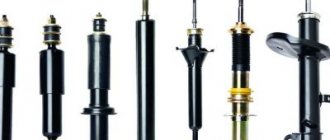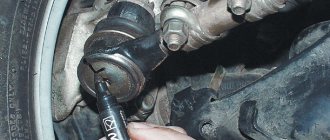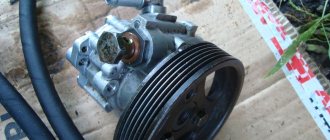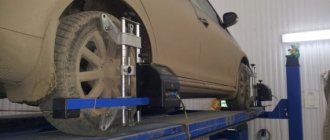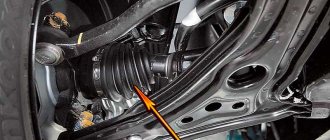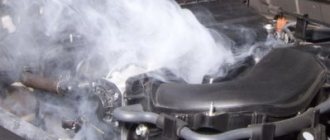Unusual reasons
Often sounds may not appear due to the failure of any element; non-standard reasons also occur. For example, one car enthusiast experienced a knocking noise after a pebble flew onto the subframe and got stuck there.
When the steering wheel was turned, the elements shifted, but they ran over this pebble, and when the steering wheel moved back, they jumped off it, making a knocking noise. Removing this stone eliminated the problem.
For the second car enthusiast, after repairing the suspension, the replaced front arm hit the subframe when turning, which was accompanied by a knocking sound. This problem was “cured” by raising the subframe with a pry bar.
These are somewhat unusual reasons for the appearance of knocking, but they have happened to car owners, so they should not be discounted.
In general, often the cause of extraneous sound when turning the steering wheel can be identified by carefully inspecting the front of the car, as well as checking the fastening of certain elements.
If you hear a noticeable knocking noise when you move the steering wheel left to right: diagnosis
Probable Causes
If an audible knocking sound in the front suspension when turning the steering wheel indicates wear in its constituent parts, then an extraneous clicking sound when the steering wheel rocks requires inspection of other structural elements. As a rule, the problem lies in the vehicle control system.
Statistics show that there is something to knock in the “steering wheel”. Any pairing may come under suspicion:
- Gap in the fit between the steering tip and the strut.
- Excessive play in the steering rack.
- There is a problem with the steering shaft driveshaft.
- Free movement of the steering wheel on the shaft.
- Gap in steering rod joints.
These parts are present in the design of any car. Knowing the location of all the landings, it remains to identify the defective pair.
For your information. Some old foreign cars have a folding steering column assembly, which breaks under the influence of a critical load that occurs during an accident. He can knock too.
How to identify knocking: expert methods
The classic approach to identifying a faulty unit will be explained in any garage. Its essence is trivial: just ask the assistant to shake the steering wheel and at this time put his hand on the mentioned connections.
Steering rack
However, in some situations this technology loses its relevance. In particular, it will not be possible to identify a defect in the mechanism using this method. To identify a problem in the gear-rack engagement, it is necessary to carry out the following experiment:
- If there is power steering (hydraulic booster): a knocking sound appears when the steering wheel is rotated on a car with the engine turned off, but when the engine is running, there is no knocking at the place.
- There is no power steering: drive along a road section with a changeable direction - when you swing the steering wheel left to right, a knock is heard, but when turning, the rack does not knock due to the small wear of the working surfaces of the gearing in the extreme positions.
For your information. It is not recommended to tighten a worn rack. One of the owners of Hyundai Solaris performed this procedure and after 10,000-12,000 km the steering wheel began to bite. An autopsy showed that the mechanism was beyond repair.
Emergency system
It is also possible to determine experimentally whether the steering column folding assembly is the cause of the knocking. It is enough to swing the “steering wheel” to the sides, while simultaneously pressing it to the bottom. The sound disappeared - the problem is in the emergency system.
Steering rack tightening
- In the very center of the steering rack, strictly on the opposite side, by touch we look for a rubber cap, which we remove from its place with our hands or with a screwdriver.
Any car enthusiast will enjoy this view from above. - Then, using a special key, we get to the rail and fix it in the seat.
- When performing work from the engine compartment, turn the key counterclockwise (when repairing under the car, clockwise - approx.).
It is on this seat (indicated by the yellow arrow) that the key should be fixed. - There is no need to tighten the rack; during the first tightening, the moment from the initial position should not exceed more than 30 degrees.
A little theory: front suspension design
Before attempting to fix any problem, there is a tendency to look at the blueprints or repair manual. It is known that the VAZ-2192 parts catalog contains the following object:
This is what the steering rack looks like in the drawing
Whether the knock will remain in the steering rack of Kalina-2 depends on the following: how accurately element “14” is adjusted. The adjusting nut, marked “14”, looks almost invisible here. But first impressions are deceiving. In the catalog, by the way, the element is called “Stop Nut”.
It is important to know that the thrust nut has external threads. And it spins clockwise. And the words “tighten the rack” mean screwing in the specified nut, and nothing more.
Now let's move on to practice and see what the node in question looks like in reality:
If you remove the rail, it looks like this
The nut has a non-standard notch, and it can only be rotated with a special tool. By the way, the recess will be closed with a cap. In the catalog it is designated by the number “15”, and now, let’s look at the appearance of the special key:
Rack adjustment key
The thrust nut is turned at small angles. We are talking about values of 10-15 degrees. What happens if you overdo it with tightening the rack? The knocking noise will disappear, but the steering wheel will turn with difficulty. Therefore, if necessary, the nut can be pulled back.
Step-by-step order of preparatory work
If you are not the lucky owner of a garage with a pit or a lift, work on tightening the steering rack can be done on the ground, but before doing this you need to prepare the work area.
- First of all, remove the battery, unscrew the terminals and fasteners of the batteries one by one (if available - approx.).
Remove the battery clamps carefully - We remove the battery and put it aside.
- Next, remove the mat under which there are 4 more bolts securing the battery stand.
By unscrewing these 4 bolts around the perimeter, the pillow can be easily removed - Then we move it forward a little so that it is detached from the air filter mounting pad.
- When nothing interferes with it, we move it in the opposite direction as much as is convenient for working with the steering rack.
Preparatory actions, dismantling unnecessary parts
To remove the crankcase protection, you need to unscrew 4 screws located in one row near the bumper. Also, unscrew two screws having a standard size of M6x16. In some configurations, the protection consists of two parts, but in this case they are attached only with self-tapping screws. These words are illustrated by the following photo:
First, unscrew the “10” screws, and then the two “18” screws. In the second case, there will be more screws (eight).
Now let's look at how to remove the battery. First of all, disconnect its terminals. Then, you need to move the additional fuse box to the side. In general, actions are performed according to the photo:
You also need to remove the mounting platform itself, for which you unscrew 4 screws. You will need a 13mm wrench, as well as a 10mm spanner. We will repeat the entire sequence again:
- Unscrew the nuts holding the battery terminals using a 10 mm wrench;
- Remove both terminals;
- Move the fuse box to the side by unscrewing 2 fastening screws;
- Unscrew the nuts with a 10mm wrench and remove the battery;
- Unscrew the screws with a 13mm wrench and remove the metal plate.
Just in case, here is a look at the fuse box mountings:
Mounting screws are located under the casing
Signs of a faulty steering mechanism
The first time after purchasing a car, novice drivers pay more attention to the road situation, without really listening to the behavior of the car.
The skill of keeping an eye on both the road and the car itself only comes with time.
This skill is very important because it allows a possible malfunction to be identified at an early stage, which can not only significantly reduce the cost of repairs, but also affect safety.
And it is not always possible to contact the service for diagnostics.
Any car consists of many components and mechanisms, and problems can arise with each of them. Moreover, a number of components of the car are responsible for safety during movement, so their condition must be monitored first.
New Lada: Operating temperature of the 8-valve Lada Granta engine
These components include the steering mechanism.
Most malfunctions in cars are accompanied by the appearance of third-party sounds - noises, squeals, knocks.
And an experienced driver is able to determine, when they appear, which unit has problems.
But for example, not every experienced driver is able to identify the cause of a knock when pressing the brake or gas pedal.
The main sign of problems with the steering mechanism is also the appearance of third-party sounds.
Most often, the knocking occurs when the steering wheel is turned either in one or both directions.
Although it is worth noting that this is not always the case, the fault may also be with another component of the car, located next to the steering mechanism.
A knock in the steering mechanism is not a problem for certain car brands; it can appear in the Soviet-made VAZ-2106, in the new domestic Kalina, and in cars from European and Asian manufacturers.
Of course, the likelihood of such a problem occurring in a foreign brand car is somewhat lower than in Kalina, but it does exist.
The fault is often due to poor quality assembly of the car. The same VAZ “Kalina” is already structurally approaching foreign cars, but its assembly is still “lame”.
But Kalina and other cars from VAZ are still in demand, because their price is an order of magnitude lower than in Europe.
Therefore, a large segment of cars on our roads is occupied by domestically produced models.
Signs that your steering rack needs to be tightened
First, you need to turn down the radio volume and listen to the suspension work. If at low speeds there is a knocking sound over small irregularities, there may, of course, be several reasons, but the most likely is a loose steering rack. Secondly, you need to constantly monitor the steering play; its presence also indicates that the steering rack is not working in normal mode.
Moreover, the presence of play is an unpleasant signal; it makes the steering wheel’s reaction unpredictability in response to your actions, and even with a play of 10 degrees you will not pass the state inspection.
Causes related to drive and suspension
Now let's move on to other elements of the car in which knocking may occur when turning the steering wheel. There are not many of them, but malfunctions with them can lead to expensive repairs
If you hear a knocking sound with a crunching effect when the wheel is turned completely, this often indicates severe wear of the constant velocity joint (CV joint) used in the wheel drive mechanism.
The CV joint itself is a fairly reliable element if it is protected from dust and dirt getting inside. Read on the topic - replacing the inner CV joint boot of popular car models.
Therefore, it is quite easy to determine that this is the cause of the knocking when turning - you need to carefully inspect the protective boot.
If it is damaged, we can say with complete confidence that the cause of the third-party crunch is the CV joint.
Many car enthusiasts claim that it is possible to fully restore the performance of the CV joint by removing it, washing it and adding new lubricant.
Some additionally add small shavings of soft plastic to the lubricant, for example, from a cork from a Champagne bottle. Be sure to replace the damaged boot.
However, such measures can only delay the replacement of the hinge for a while and in the end it will still have to be replaced. And when to perform this operation - immediately upon detection of damage to the boot, or a little later - it is up to the car enthusiast to decide.
In many modern domestic cars, the weak point is the shock absorber strut bearing. It can also cause knocking.
This problem seems to be easily solved - it is enough to replace the support, but sometimes this is not very easy to do. After all, you will have to remove the entire rack from the car.
Also, a broken strut spring may be knocking in the suspension. At the same time, it will no longer be able to fully perform its functions, which will lead to rapid failure of the shock absorber.
Therefore, if noise appears, you should immediately inspect the spring. If it bursts, you will have to change it, and it is changed in pairs on both sides of the car.
New Lada: ✅ How to remove the radio on a luxury grant -
If you hear a knocking sound on your car when turning, but it is also accompanied by a hum, it is likely that all this is due to wear on the wheel bearing.
It is quite easy to diagnose his condition.
You need to jack up the wheel on the side where the knock is coming from and rock it, checking for axial play.
If such play exists, the bearing needs to be replaced, which is impossible to do without the appropriate equipment and knowledge.
Preventing knocking noises
All of the above problems can arise not only with domestic cars, but also with expensive foreign cars. And the difference between these cars comes down only to the time after which the malfunction appears.
Naturally, a foreign car will pass more without a malfunction than the same Priora. But repairing a foreign car, if, for example, its CV joint has failed, will cost much more.
In most cases, knocking noises are caused by inadequate road surfaces. Moving over bumps and holes leads to the fact that all fasteners begin to weaken, hence the appearance of backlash.
To prevent knocking noises when turning the steering wheel, periodic inspection of all elements is required. Moreover, this will require very little, and you can do everything yourself.
The car is placed on an inspection hole or overpass, after which, while under it, you should carefully inspect all the elements, check the tightness of all fasteners with wrenches, tighten the nuts and bolts if necessary, swing the levers with a pry bar, checking for play.
If you do all this periodically, you can avoid the occurrence of knocking noises, or at least increase the life of the car before they occur.
Also, when traveling, you need to adhere to the speed limit, and go through difficult sections at low speed in order to slightly reduce the load on the elements of the suspension steering mechanism.
And if in front of you unexpectedly there are depressions in the road surface, then slow down the car (the car will seem to nose down), and immediately before the problem section of the road, release the brake pedal.
The front of the car will rise, thereby unloading the front suspension, and the car will coast over uneven roads without much damage to the chassis.
Preparing for diagnosis
You need to start by trying to determine the location and nature of the sound. A clear and loud knock in the steering wheel is generated by the impacts of metal on metal, while a muffled knock is generated by metal on plastic. Check the tire pressure: their difference can also cause noise.
Before inspection, you need to clean the front suspension, the easiest way is with a powerful jet of water. After it dries, you can put the car on a pit or viewing platform. There you need to wipe the parts dry with a rag and, if necessary, clean off dried dirt or rust with a brush. Among other things, this way you will save yourself from sand falling from above.
When preparing to diagnose the suspension, you should pay attention to the tightening of the threads, rubber cushions and boots.
Tightening process, video
There are several ways to tighten. One of them is the method of removing the slats. The removed rail is clamped in a vice and then, using a special wrench, the nut is tightened 10-15 degrees by turning it counterclockwise.
This is followed by a check for backlash and, if necessary, the procedure is repeated, since the backlash can be more or less. It is not advisable to overtighten, it will be difficult to rotate the steering wheel. The advantage of this method is the ease of adjustment, but the disadvantage is that you have to remove and then put the steering rack back in place, and this requires time, certain knowledge and skills.
The second method is simpler, it does not require removing the steering rack, you just need to remove the battery and the platform under it with four bolts, but it is much easier and faster than removing and installing the steering rack. This way we gain access to the steering rack and steering rods.
We take hold of the rod with our hand and begin to shake it with force. A characteristic knock will immediately indicate the presence of play. The stop nut is located on the rack behind the left link from the bottom; you need to feel it with your finger. Now the task is to get the wrench into the nut and then turn it counterclockwise. We check for play and, if necessary, tighten it further.
But in the video there is another tightening option, even without removing the battery:
Dismantling and disassembling the electric amplifier
Before removing the amplifier, you need to remove all the steering column switches. Remove the steering rack cover and dismantle the devices, remembering to disconnect the connectors from the power supply.
How to remove the EUR with your own hands:
- After removing the switches, you will need to dismantle the lower cross member of the dashboard. To do this, you need to press the fasteners that secure the connector with wires, and then disconnect the wiring from the control module. Once these steps are completed, you can disconnect the connector from the switches.
- The system bracket is secured with nuts; you will need to unscrew them with a wrench.
- After this, the steering rack will need to be carefully lowered down. To do this, you will need to find the bolt that secures the driveshaft to the booster shaft. This bolt must be unscrewed, but when unscrewing, you will need to fix the nut, this will prevent it from turning. When the bolt is removed, the fastening will need to be loosened, after which the intermediate shaft will be carefully removed. At this stage, we recommend marking the position of the shaft and gears; you can use a marker for this. This step is very important because doing it will prevent possible installation problems in the future. If the marks on the shafts do not match, this may cause problems with the amplifier. When dismantling, be careful not to damage the wiring, as this will also lead to the inoperability of the ESD.
- When the unit is dismantled, it will need to be disassembled and the failed elements replaced. Further editing is done in reverse order (the author of the video is Murzik Bely).
Common causes of knocking noise associated with the steering mechanism
Now let's look at typical problems and how to fix them.
The first thing you need to do is check the pressure in the wheels, because the difference in tire inflation may be the cause of the knocking.
Then check the fastening of the plastic protective fender liners. It is quite possible that the screws that secure them to the body have broken out, causing the fender liner to come off and cling to the wheel, making a knocking sound when turning.
In general, such a malfunction is very easy to fix; all you need to do is secure the torn fender liner with new screws.
The most dangerous from a safety point of view is the appearance of a knock in the steering mechanism itself. To check the condition of the mechanism, you will need to drive the car onto an overpass.
New Lada: Cylinder head - Lada Kalina / Lada Kalina (VAZ 1118, 117, 1119)
The first thing you need to check is the steering ends. Damage to the tip boot leads to sand getting inside it, which intensively wears out the surfaces of this element, causing play to appear in the tip, which is the source of knocking.
You can check the condition of the ends by loosening the tie rod with a pry bar.
Strong play and knocking will indicate wear on the tip and the need to replace it.
Steering ends for domestic cars are relatively inexpensive, and you can purchase them at almost any auto store.
Replacing them is also easy. It is recommended to replace both tips at once.
The complexity of performing this work comes down to the need to use a special puller.
After replacing the tips, you will still have to contact a service station to set the wheel alignment angles.
A knock may also appear in the steering rod silent blocks. They are located in the place where these rods are attached to the steering rack.
Delamination of the rubber of these silent blocks can also lead to knocking, although it will appear not only when turning, but constantly while driving.
This steering mechanism malfunction, although very rare, is still possible. It can be eliminated by removing the steering rods and pressing in new silent blocks.
A knock may also appear in the steering mechanism itself. It usually forms after the rack guide bushings wear out, causing a gap to appear between the rack and gear.
In some cases, everything can be eliminated by removing the gap with the mechanism's adjusting bolt.
If this is no longer possible, you will need to remove the mechanism from the car, disassemble it and replace the worn guide bushings.
A knock may even appear in the steering column universal joint.
If for some reason it is damaged, it is quite possible that it is the cause of the appearance of third-party sounds. This problem is “treated” by replacing the cardan.
You should also check the fastening of the mechanism body to the car body. Loose clamps may cause noise. This can all be eliminated by tightening the fastening nuts.
Design Features
The steering system of the Lada Kalina includes an electric power steering and a steering column that is adjustable in height and tilt. The steering mechanism is a steering rack with a variable transmission ratio. The rack engages with the engine crankcase through a gear having helical teeth, the pitch of which varies along the length of the rack. The figure shows the design of the Kalina steering rack.
The steering rack on Kalina is pressed against the gear by a spring. Friction is reduced by a plastic insert. The spring pressure is changed with an adjusting nut (the factory-set gap between the rack and the shaft is 0.1 mm). The second end of the rail rests against a plastic sleeve. Adjusting the gap helps eliminate knocking noises.
The steering system shaft is installed in bearings (one in the column bracket, the other in the electric booster housing). The column bracket is attached to the pedal bracket (front) and to the body bracket. The column bracket with the pipe is connected in the form of a hinge of two plates, which allows you to change the position of the steering wheel, and the range of movement is limited by the slots in the plates.
To fix the position of the pipe, there is a lever connected to the adjusting sleeve. It is screwed into a coupling bolt located in the slots of the plates. When you turn the lever, the bushing rotates, loosening the fixation of the plate, which allows you to change the position of the steering wheel. Springs between the plates and the bracket pull the pipe up when the fastening is loosened.
The steering system of the Lada Kalina has two tie rods and swing arms. The rod consists of external and internal tips and an adjusting threaded sleeve, which, when rotated, changes the length of the rod. The required adjustment of the rods is fixed with bolts. The rod is connected to the swing arm using an external tip that has a ball-type joint.
Kalina's electric power steering reduces the force applied to the steering wheel. It is assembled on the basis of an electric motor with a gearbox located under the steering system casing. The amplifier is controlled by an electronic unit that receives signals from sensors of vehicle speed, shaft rotation and steering torque.
The principle of operation of the amplifier is based on the fact that when the car is stationary, the torque on the steering shaft is the greatest, and when moving, it decreases with increasing speed. There is a power steering indicator on the dashboard.
Repair, price
A lift is a fairly simple and quick way, but often it is only a partial, temporary solution to the problem. After all, the appearance of play can be caused by various reasons - the boot may be damaged, gaskets may leak and who knows what else, that is, there is a high probability that the steering rack is running dry.
If you suspect the need for repairs, consider whether you can handle it yourself. Get ready for the fact that you will have to spend the whole day in interesting positions, and you will also need an assistant to perform some operations. Do you know how to install the rack so that the steering wheel is level? If not, you risk having to do the installation again.
An alternative is a service station. They will charge you around 3,500 rubles for repairs, the repair kit costs 200 rubles and another 200 will be spent on anthers and so on.
The easiest option is to buy a new rack, complete with rods for about 6,000 rubles, there are, of course, racks with bells and whistles (short-stroke, sports, etc.), these cost about 10,000 rubles, the choice is yours.
Love and respect your steering rack and it will love you back!
Steering rack - simplicity and reliability
The steering mechanism of a car is designed to change the direction of its movement. It has been tested and tested for more than a hundred years, but meticulous designers still find new solutions to improve its performance.
The steering rack is no exception - a relatively simple and reliable mechanism, the operating principle of which is based on the interaction of the “rack-and-pinion steering shaft worm” pair, which converts the rotational movement of the steering shaft into the reciprocating movement of the steering rods.
